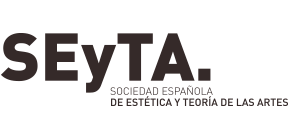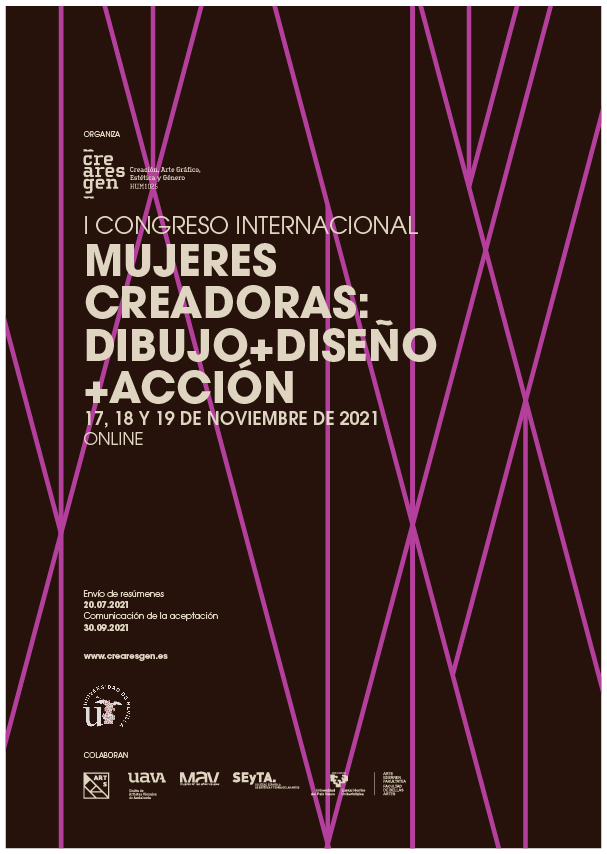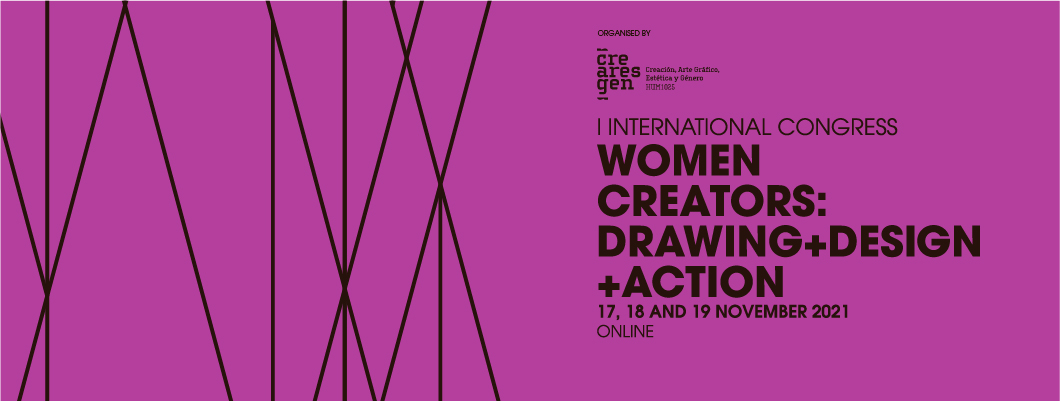17, 18 y 19 de noviembre de 2021, online. Este congreso tiene el objetivo de visibilizar en el ámbito académico la investigación científica y artística centrada en mujeres artistas y diseñadoras cuya esencia esté vinculada al dibujo o aquellos aspectos que se acerquen a él: desde el pensamiento gráfico, la formalización plástica, la producción en arte gráfico o la estética. Envío de resúmenes hasta el 20 de julio de 2021.
CALL FOR PAPERS/
El I Congreso Internacional Mujeres Creadoras: Dibujo, diseño y acción tiene el objetivo de visibilizar en el ámbito académico la investigación científica y artística centrada en mujeres artistas y diseñadoras cuya esencia esté vinculada al dibujo o aquellos aspectos que se acerquen a él: desde el pensamiento gráfico, la formalización plástica, la producción en arte gráfico o la estética.
Organizado por el Grupo de Investigación HUM-1025 Creación, Arte Gráfico, Estética y Género de la Universidad de Sevilla, tras el éxito de las I Jornadas Mujeres Creadoras: Dibujo, trazo y discurso, celebradas en diciembre de 2020. El evento académico se dirige a perfiles de investigadores o artistas del ámbito de las Bellas Artes, Historia del Arte, Diseño, Filosofía, Estudios de Género o Estética.
Se aceptan resúmenes extendidos de 4.000 palabras mediante plantilla que se proporciona y que se someterá a revisión de pares ciegos. Estos resúmenes, una vez aprobados y presentados en el encuentro, se publicarán en editorial con ISBN.
Idiomas: castellano, inglés, italiano.
EJES Y LÍNEAS DE INVESTIGACIÓN/
• Dibujo y creación gráfica realizada por mujeres artistas y/o diseñadoras.
• Obra gráfica, impacto y producción de diseñadoras.
• Pensamiento estético feminista en su vinculación con el dibujo y el diseño.
• Artistas de la performance o instalación en cuyas obras el dibujo o lenguaje gráfico sea la base de sus acciones.
PUBLICACIÓN EXTENDIDA/
Tras la celebración del encuentro, se editará una publicación de los resúmenes aceptados.
Además, con posterioridad, se publicará también un libro de capítulos en el que el equipo de investigación HUM-1025 CREARESGEN, Creación, Arte Gráfico, Estética y Género invitará a una selección de participantes del congreso internacional. Publicación de resultados mediante un sistema de peer reviewed, que se enviarán el 15 de febrero de 2022 como fecha límite. La comunicación de los capítulos seleccionados se hará el 15 de abril de 2022. Ambas ediciones tendrán ISBN.
FECHAS/
Envío de resúmenes 20 de julio de 2021
Confirmación de resúmenes aceptados 30 de septiembre de 2021
Celebración encuentro online 17 (tarde), 18 y 19 (mañana y tarde) noviembre de 2021
ENVÍO DE PROPUESTAS/
Envío de propuestas e información: jornadasmujerescreadoras@gmail.com
INSCRIPCIONES/
(hasta completar aforo online).
COMUNICANTES / 1-15 octubre / 75 euros
ASISTENTES / Hasta el 12 noviembre / 20 euros
ASISTENTES estudiantes Universidad de Sevilla y País Vasco; estudiantes escuelas de Arte y Diseño en España; socios/as de UAVA, SEyTA y MAV Andalucía / Hasta el 12 de noviembre / 10 euros
ORGANIZA/
Grupo de Investigación HUM-1025 CREARESGEN. Creación, Arte Gráfico, Estética y Género. Universidad de Sevilla
COLABORAN/
Facultad de Bellas Artes del País Vasco UPV/EHU
ARTSevilla
Sociedad Española de Estética y Teoría de las Artes SEyTA
Unión de Artistas Visuales de Andalucía UAVA
Asociación de Mujeres en las Artes Visuales MAV
NORMAS DE ESTILO PARA AUTORAS/ES/
EXTENSIÓN, TIPO DE LETRA E IDIOMA
La extensión de los textos será de 4.000 palabras, incluidas las notas y bibliografía. El tipo de letra a utilizar será Times New Roman, fuente 11, con espaciado a 1,5, notas al final del texto, tablas y figuras en páginas separadas.
Idiomas que se aceptan: castellano, inglés, italiano.
PRIMERAS PÁGINAS
Título del artículo
Debe ser conciso e informativo, con un máximo de 80 caracteres.
Resumen
Ha de estar escrito en negrita y su longitud no debe ser superior a 200 palabras.
Abstract
Ha de estar escrito en estilo normal, inglés, 200 palabras.
Palabras clave
Serán 5 como máximo, y en orden alfabético, separadas por comas.
Breve biografía
a. Sus datos (nombre y apellidos, institución, dirección de trabajo y correo electrónico, teléfono)
b. Una breve reseña biográfica (máximo de 160 palabras) siendo imprescindible citar:
• Lugar y fecha de nacimiento,
• Escuela o Facultad, Universidad y fecha de obtención del título de doctor/a (en su caso, o análogos), y también la categoría docente adquirida.
• Nombres de 3-5 artículos y/o libros que haya publicado recientemente (número, año).
NOTAS
Todas las notas irán a pie de página en Times New Roman, tamaño 10.
La extensión máxima de todas las notas no superará las 1.000 palabras.
Se usarán las comillas dobles.
Las citas extensas (más de 40 palabras) no estarán entrecomilladas y se presentarán separadas del párrafo, tamaño Times 10.
REFERENCIAS
Deberá ajustarse rigurosamente a las normas que se especifican a continuación.
Se incluirá también una bibliografía (referida exclusivamente a la utilizada en las notas al final del texto) al final del artículo, ordenadas alfabéticamente.
Para la bibliografía citada (bibliografía al final del artículo) se seguirá la norma UNE-ISO 690:2013 (idéntica a la Norma Internacional ISO 690:2010). Cuando la referencia bibliográfica disponga de DOI (Digital Object Identifier) deberá indicarse al final de la misma.
Libro/monografía
Nombre Apellido, Título. Ciudad: Editorial, año.
Ejemplo: Erika Bornay, Arte se escribe con M de mujer: Mujeres creadas- Mujeres creadoras. Barcelona: SD Edicions, 2010.
Capítulo de libro/monografía
Nombre Apellido, “Título del capítulo”. En: Título del libro. Ciudad: Editorial, año, páginas.
Ejemplo: Ana María Huesca, “Programa del Bauhaus de Weimar”. En: Hans M. Wingler, La Bauhaus. Weimar Dessau Berlin 1919-1933. Barcelona: Gustavo Gili, 1975, pp. 40-43.
Artículo de revista
Revista impresa
Nombre Apellido, “Título del artículo”, Título de la revista, número, fecha, páginas.
Ejemplo: Silvia Ariza, “De la práctica a la investigación en el arte contemporáneo, producir conocimiento desde la creación”, Arte, individuo y sociedad, n. 33/2, 2021, pp. 537-552.
Revista digital
Nombre Apellido, Título [En línea]. Editorial, Ciudad, año. [Consulta:]
Alejandro Ratia: El vuelo. 1978-2018. Paloma Navares. Musac [en línea]. Artecontexto, 23/11/2020. https://www.artecontexto.com/es/blog.html [Consulta: 12 de diciembre de 2020]
Fuentes de archivo
Las referencias a fuentes primarias figurarán únicamente en las notas y no en la bibliografía. Se citará el nombre del documento en cursiva, seguido de la fecha, el nombre del archivo y el lugar de localización, el fondo, legajo y expediente. Entre paréntesis, se indicará en la primera cita la abreviatura del archivo, que se utilizará en las citas siguientes.
Ejemplo: Diploma de estudios de Wera Meyer-Waldeck, Bauhaus-Archiv Berlin (BHA), original, Inv. Nº 11463/7-10.
Otras referencias
Artículos de prensa
Los artículos de prensa sin autor se citarán sólo en nota, indicando el título y el nombre del diario, lugar si fuera preciso, seguido de la fecha y páginas.
Tesis o disertación
Nombre Apellido (año). Título de tesis en letra redonda (Tesis doctoral no publicada). Ciudad: Universidad.
Ponencias/Congresos/Conferencias/Seminarios
Nombre Apellido (año, día y mes). Título de artículo, ponencia, seminario. En Nombre de Congreso/Simposio/Jornadas (pp. ¿-?). Ciudad: Editorial.
Documentos de Internet
Nombre Apellido (año): “Título”. En: [fecha de consulta].
FIGURAS, TABLAS E IMÁGENES
El número de imágenes aportadas no será mayor de 8. Las imágenes seleccionadas deberán ser explicativas del texto (dibujos, planos, cuadros, fotos de arquitectura, etc.). Las imágenes tendrán formato JPG/TIFF, y resolución de 300 dpi, tamaño aproximado A5.
La posición de las figuras, las ilustraciones y las tablas será reseñada en el texto entre paréntesis (fig. Z). Se incluirán al final del texto, en páginas separadas, con su correspondiente leyenda en Times New Roman, tamaño 10. Se incluirán en páginas separadas al final del texto, cada una de ellas. Las imágenes deberán mencionar su fuente. Fuente: en cursiva.
I INTERNATIONAL CONGRESS OF WOMEN CREATORS: DRAWING, DESIGN AND ACTION
17, 18 and 19 November
Online format
CALL FOR PAPERS/
The aim of this I International Congress of Female Creators: Drawing, Design and Action, is to make visible in the academic field the scientific and artistic research focused on women artist and designers whose essence is linked to drawing or those aspects that are close to it: namely the graphic reflection, the plastic formalization, the graphic art production or the aesthetics.
Organized by the Research Group HUM-1025 Creación, Arte Gráfico, Estética y Género of the Universidad de Sevilla, following the success of the I Meeting Women Creators: Drawing, stroke and discourse, celebrated in December 2020. The academic event is aimed at research profiles or artists in the field of Fine Arts, Art History, Design, Philosophy, Gender Studies or Aesthetics.
Extended abstract of 4000 words using the template provided, which will be submitted for blind peer review. These abstracts, once approved and presented at the meeting, will be published with isbn.
Accepted languages: Spanish, English, Italian.
AREAS AND LINES OF RESEARCH/
-Drawing and graphic creation by woman artists and/or designers.
-Graphic work, impact and production of women designers.
-Feminist aesthetic thought as it relates to drawing and design.
-Performance or installation artists whose work uses drawing or graphic language as the basis for their actions.
EXTENDED PUBLICATION/
After the meeting, a publication of the accepted abstracts will be published.
In addition, a book of chapters will be published afterwards, to which the research team HUM-1025 CREARESGEN, Creación, Arte Gráfico, Estética y Género, will invite a selection of participants of the international congress. Publications of results through peer review system, which must be sent by 15 February 2022 as a deadline. Selected papers will be communicated by 15 April 2022.
Both editions will be published with isbn.
DATES/
Call for papers. Abstracts 20th July
Confirmation of accepted abstracts 30th September
Online meeting 17 (afternoon), 18 y 19 (morning and afternoon) November
SENDING PROPOSALS/
Sending proposals and information: jornadasmujerescreadoras@gmail.com
REGISTRATION/
(until full online capacity is reached).
COMMUNICANTS / 1st-15th October / 75 euros
ATTENDANTS / Until 12th November / 20 euros
ATTENDANTS students from the Universidad de Sevilla and País Vasco. Students from Art and Design schools in Spain. UAVA, SEYTA and MAV Andalucía / Until 12th November / 10 euros
ORGANISED BY/
Research Group HUM-1025 CREARESGEN. Creation, Graphic Art, Aesthetics and Gender. University of Seville.
IN COLLABORATION WITH/
Facultad de Bellas Artes del País Vasco UPV/EHU. -Faculty of Fine Arts of the Basque Country UPV/EHU.-.
ARTSevilla
Sociedad Estética y SEYTA -Aesthetic Society and SEYTA-.
Unión de Artistas Visuales de Andalucía UAVA -Union of Visual Artists of Andalusia UAVA-.
Asociación de Mujeres en las Artes Visuales MAV -Association of Women in the Visual Arts MAV-.
Style guidelines for authors/
LENGTH, FONT AND LANGUAJE
The extension of the text must be 4.000 words, including notes and bibliography. The font to be used will be Times new Roman, font size 11, with spacing at 1.5, notes at the end of the text, charts and graphs on separate pages.
Accepted languages: Spanish, English, Italian.
FRONT PAGE
Title
It must be concise and informative, with a maximum of 80 characters.
Abstract
It must be written in a bold typeface and its length must not exceed 200 words.
English Abstract
It must be written in regular font, English, 200 words.
Key words
A maximum of 5, in alphabetical order, separated by commas.
Short biography
a. Data (name and surname, institution, work address and e-mail, phone number).
b. A brief biographical sketch (maximum of 160 words), it is essential to cite:
.Place and date of birth.
.School or College, University and date of obtaining doctoral degree (if applicable, or equivalent), as well as the academic category acquired.
Names of 3-5 Journals and/or books recently published (number, year).
NOTES
All footnotes must be in Times New Roman, size 10.
The maximum length of all notes should not exceed 1.000 words.
Double inverted commas should be used.
Long quotations (more than 40 words) should not be enclosed in quotation marks and should be presented separately from the paragraph, Times New Roman, size 10.
REFERENCES
The following rules must be rigorously followed.
A bibliography (referring exclusively to that included in the endnotes) should be provided at the end of the article, in alphabetical order.
*For the cited bibliography (enclosed at the end of the article), the UNE-ISO 690:2013 standard (identical to the International Standard ISO 690:2010) must be used. Whenever the bibliographic reference has a DOI (Digital Object Identifier), it must be indicated at the end of the reference.
Book/monograph
First name Surname, Title. City: Publisher, year.
Example: Erika Bornay, Arte se escribe con M de Mujer: Mujeres creadas-Mujeres creadoras. Barcelona: SD Edicions, 2010.
Book chapter/monograph
First name and Surname, “Title of the chapter”. In: Title of the book. City: Publisher, year, pages.
Example: Ana María Huesca, “Programa del Bauhaus de Weimar”. En: Hans M. Wingler, La Bauhaus. Weimar Dessau Berlin 1919-1933. Barcelona: Gustavo Gili, 1975, pp. 40-43.
Journal article
Printed journal
First name Surname, “Title of the article”, Title of the journal, issue, date, pages.
Example: Silvia Ariza, “De la práctica a la investigación en el arte contemporáneo, producir conocimiento desde la creación”, Arte, individuo y sociedad, n.33/2, 2021, pp.537-552.
Digital journal
First name Surname, Title [Online]. Publisher, City, Year. <website address> [Accessed].
Ejemplo: Alejandro Ratia: El vuelo. 1978-2018. Paloma Navares. Musac [Online]. Artecontexto, 23/11/2020. https://www.artecontexto.com/es/blog.html [Accessed: 12th December, 2020].
Archival sources
References to primary sources will appear only in the notes and not in the bibliography. The name of the document should be cited in italics, followed by the date, the name of the archive and the place of location, fond, file and dossier. In brackets, the abbreviation of the archive, to be used in subsequent citations, should be given in the first citation.
Example:
Diploma de estudios de Wera Meyer-Waldeck, Bauhaus-Archiv Berlin (BHA), original, Inv.Nª 11463/7-10.
Other references
Press articles
Press articles without author should be cited only in footnote, giving the title and name of the newspaper, place if necessary, followed by the date and pages.
Thesis or dissertation
First name Surname (year). Title of thesis in round letters (Unpublished doctoral thesis). City: University.
Papers/Congresses/Conferences/Seminars
First name Surname (year, day and month). Title of the article, paper, seminar. In Name of Congress/Symposium/Seminar (pp. ¿-?). City: Publisher
Documents on the Internet
First name Surname (year): “Title”. In: http://www.[full URL] [date accessed].
FIGURES, CHARTS AND IMAGES
The number of images provided shall not exceed 8. The images selected must be explanatory of the text (drawing, plans, charts, architectural photos, etc.). The images shall be in JPG/TIFF format, with a resolution of 300 dpi, size approximately A5.
The position of figures, illustrations and tables shall be indicated in the text in brackets (fig. Z). They should be included at the end of the text, on separate pages, with their corresponding captions in Times New Roman, size 10. Images must mention their source. Font: in italics.










